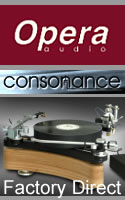|
|
You are reading the older HTML site
Positive Feedback
ISSUE
58
audio-technica AT150MLx Cartridge as reviewed by Ed Kobesky
It was a terrifying realization: I do not own a Chevrolet Suburban. Much as I enjoy my little Mazda 3 GT (the sound system of which was reviewed here), what if I need to transport eight large people, plus luggage and pets, through the woods in a blizzard? Or tow 8,600 pounds worth of, say, Linn LP12 springs and grommets? I'd otherwise be out of luck. True, it only gets 12 miles per gallon, so it won't be used every day. Also true, it's total overkill for a single guy with no children. But heck, on those rare occasions when you need a Suburban, you need a Suburban. Something else you don't really need, but maybe you do: Audio-Technica's AT150MLx, a moving magnet cartridge with all the stops pulled out. All you really need is the $119 AT120E/T, which is based on the same design and sounds very nice, or the $239 AT440MLa, which also shares the same body but sports significant internal improvements as well as a MicroLine stylus that tracks just about anything. If you think you need more than that, you should probably buy a moving coil cartridge and the associated pre-amplification to make the most of it.
Wait just a second though. Some people simply prefer the character of a moving magnet cartridge. Still others may own fine equipment, perhaps vintage, that simply cannot accommodate a moving coil cartridge. For them, spending $485 on the best moving magnet cartridge in Audio-Technica's US product line actually makes sense. A fair number of consumers must be thinking the same thing because the AT150MLx has competition in the form of Ortofon's 2M Black ($699), Goldring's G2500 ($650), Rega's Exact ($595), Roksan's Corus Black ($660) and Linn's Adikt ($510). All of them are at the top of their respective manufacturers' moving magnet lines, all sport very fine styli, yet the Audio-Techncia is the most conspicuously tweaked, especially compared to its siblings. For example, instead of the AT440MLa's plastic construction, you get ceramic and metal for increased rigidity and what the hell, might as well make it gold tone. You end up with a much heavier product—8.3g vs. 6.5g—that may make it difficult or impossible to balance on some tonearms. Still, it's hardly a pig. Top-of-the-line moving coils can easily weigh 12g or more and throwbacks like the Ortofon SPU series get into 30g territory, albeit with integrated headshells. Suffice it to say if the 150 won't balance on your arm, it didn't belong there in the first place. Another example is the wisp of a boron cantilever on the 150MLx. Every once in a while, I run across a piece of manufacturing that seems almost impossible and this is one of them. I've seen eyelashes that are thicker. Amazingly, it would be even thinner were it not for the uniform gold plating applied to further dampen any possible resonances. After coming this far, assemblers still have yet to mount a stylus on it, which I imagine is only slightly less difficult than threading a needle three feet away with chopsticks while gooned on horse tranquilizers. That stylus assembly has a lot to do with the overall performance of the cartridge, something I easily confirmed by replacing it with that of the lower-priced 440MLa. Same MicroLine stylus, same basic design, but with a tapered alloy cantilever instead. There was a clear loss of speed, detail and delicacy. I'm sure all the other enhanced product features makes a significant cumulative difference but the cantilever and stylus are the stars of the show. Mounting and aligning this thing was an exercise in sheer terror because it looks so vulnerable. Ashamedly, not once but twice during that process, the tonearm got away from me. (Note to Audio-Technica: thanks again for loaning me the cartridge and remember, everybody loves a sport.) The AT-150MLx emerged unharmed despite both trips across the Hi-Fi News test record. It's rare for something so seemingly delicate to be so robust in practice. Break-in wasn't an issue, nor was it with the company's low-output moving coil AT-OC9/MLII (reviewed here), which shares the same cantilever and stylus parts. I guess when something tracks that well out of the box and is reasonably compliant, it doesn't need much of loosening up. Sound-wise, the 150MLx is unmistakably a moving magnet, but compared to most, it brings extra polish and articulation. Tracking is outstanding, and it takes a lot to tax this cartridge or make it sound anything less than effortless. It has a talent for rocking out just like Audio-Technica's lower-priced offerings, but where they tend to sound wrong with more delicate acoustic or large orchestral material, the 150MLx sounds right. It's one of the most versatile cartridges I've come across regardless of price. It's not especially rich-sounding—actually, it borders on lean in the lower registers, though controlled and detailed. High frequencies are exceptionally clean and quick, which adds to the sense of leanness. That's not to say it's analytical, just maybe a little too taut for some tastes. A rich, spacious tube phono stage makes an ideal foil. Think TTVJ's Hybrid Phono Preamp (reviewed here), as a starting point. The 150MLX's midrange has a nice solid presence along with a dollop of warmth that keeps it well out of clinical territory. It starts and stops quickly for a moving magnet, but doesn't have the hyper-fast leading edge or decay performance of a good moving coil. Likewise, though airy for a moving magnet, it's not super spacious and instruments can sound clustered together a bit more closely than they otherwise should. If that seems nitpicky, it's because it is. You really have to compare this cartridge to more expensive ones in order to find significant criticisms. Most folks who will buy it won't realize its full potential. To hear it at its best is to use it with tonearms and phono preamps two to three times its cost—and those people are probably using low-output moving coils instead. But if you happen to be someone who already owns a top-flight moving magnet phono stage, this might be a great way to upgrade without turning your system upside down. After a few hundred hours, I was unable to detect any significant stylus wear, leading me to believe that a properly set-up and maintained sample should have a lifespan of at least 1500 hours and perhaps significantly longer. A replacement stylus costs $239, which strikes me as very reasonable. Not only is the 150MLx the least expensive cartridge in its class, it has the least expensive replacement stylus as well, and by a lot. There's nothing left to say except this thing is an absolute steal. Its quick, agile sound is exciting and effortless yet nuanced. Though a bit lean overall, the tradeoff is remarkable versatility across a wide range of material. A long potential lifespan and low-priced replacement styli add to the already strong value proposition. Affordable overkill is rare, but here it is. Audio-Technica's AT-150MLx is in good company among the very finest moving magnet cartridges you can buy. Ed Kobesky
AT-150MLx phono cartridge
Audio-Technica U.S., Inc.
|







